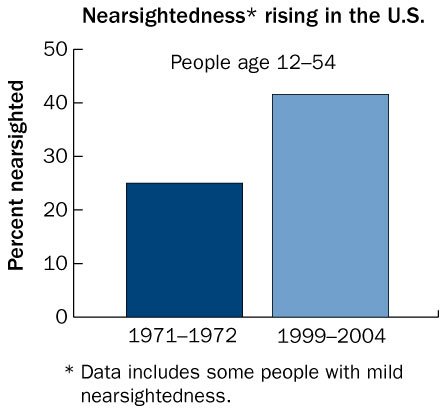
It looks like nearsightedness is on the rise in the United States.
Researchers tapped into a wide-ranging health survey to rate vision in the population in the early 1970s and roughly 30 years later. They compared eyesight information for more than 4,400 people tested in 1971 and 1972 with data from another set of 8,300 people tested from 1999 to 2004.
This broad survey showed that 25 percent of those examined in the early 1970s were deemed to be nearsighted, compared with 42 percent examined three decades later, the researchers report in the December Archives of Ophthalmology. That's an increase of 66 percent.
Myopia severity also increased, with moderate nearsightedness doubling between the two time periods and severe cases, although uncommon, also rising sharply. Mild myopia cases increased slightly, from about 13 percent to 18 percent.
This group included some people who did not need corrective lenses, says study coauthor Susan Vitale, an epidemiologist at the National Eye Institute in Bethesda, Md.
Among blacks, the overall myopia rate was lower than in whites but still jumped from 13 to 34 percent over the three-decade span.
When analyzing the more recent eye-exam data, the scientists used only diagnoses that were made with the same technology used in the 1970s - mainly standard eye tests and trial lenses. Including diagnoses made with more advanced technology that has become available only recently might have biased the comparison, Vitale says..
The cause of nearsightedness is poorly understood. Past research has linked added risk to both a genetic predisposition to nearsightedness and to excessive amounts of near work, the kind of tasks that require peering at written words or small objects.
"Some people would say near work is a reasonable explanation," Vitale says, particularly with the advent of video games and other electronic devices. Children also spend less time outdoors than they once did, she says. And some researchers contend that more outdoor time means seeing in better light, focusing farther.
As for hereditary factors, research shows some added risk for children born to nearsighted parents. "It might be that somehow the population has changed and that there are more people floating around that have more genetic risk," Vitale says.



In 1972 no one was spending 8 to 10 hours a day in front of a computer monitor. In my late forties, I took an office-type job for the first time Up until then I had very good sight, even for detail work. Five years later I am on a second level of readers and will probably need regular glasses in a couple more years.